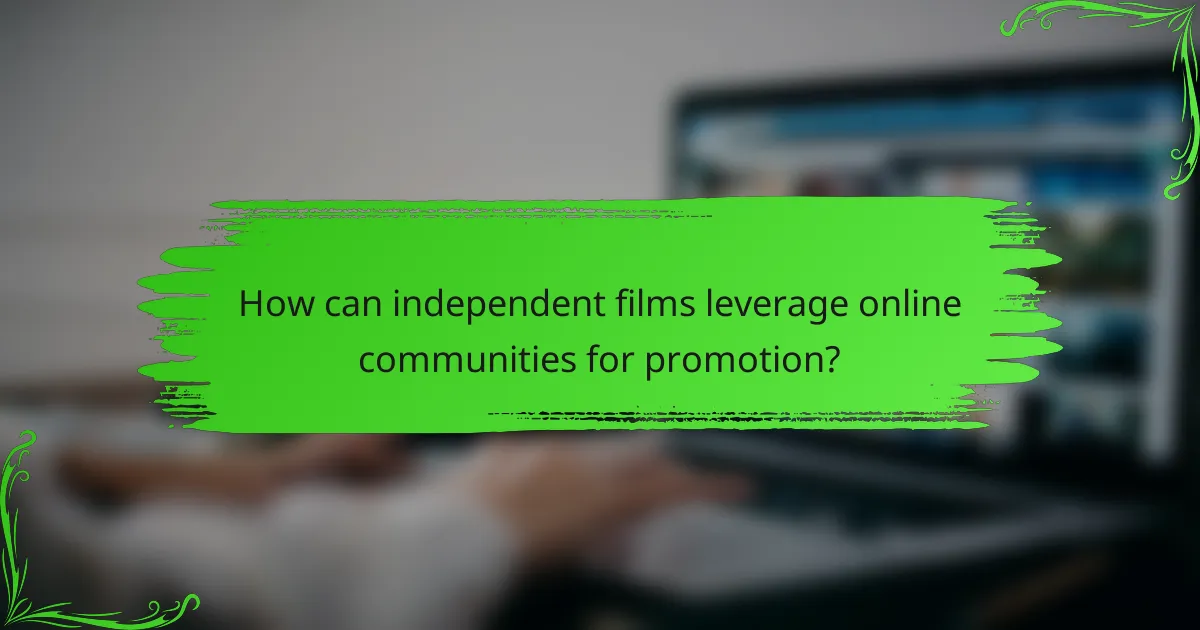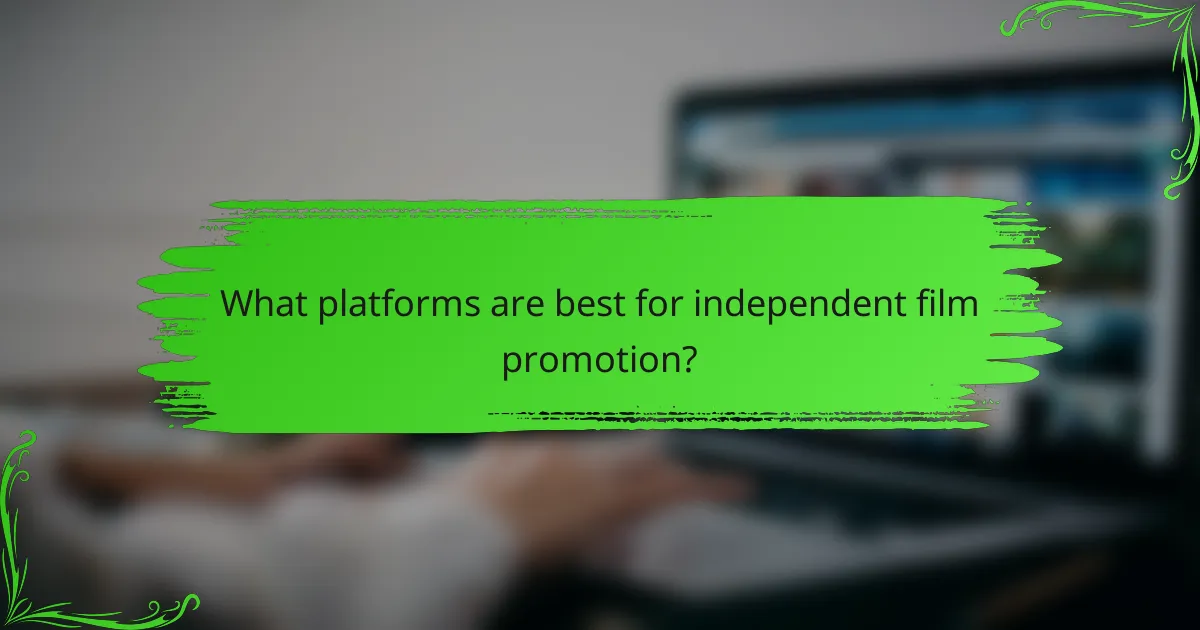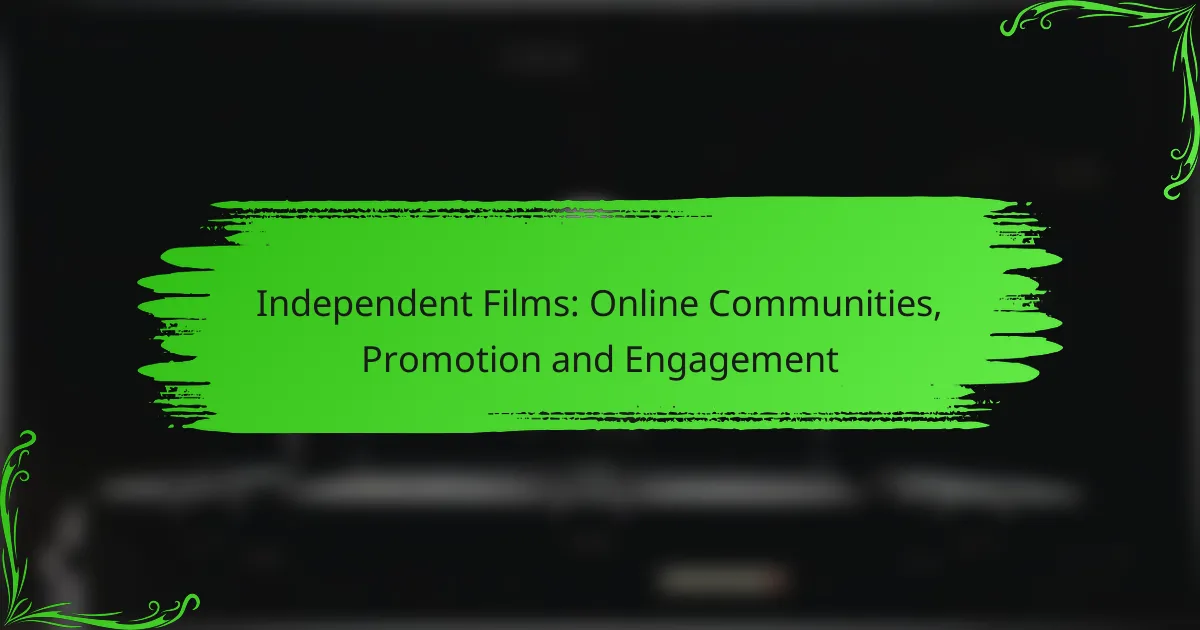Independent films have the unique opportunity to thrive by engaging with online communities that are passionate about cinema. By leveraging digital platforms and interactive strategies, filmmakers can effectively promote their projects, build a dedicated fan base, and generate excitement within their target audiences.

How can independent films leverage online communities for promotion?
Independent films can effectively promote themselves by engaging with online communities that share a passion for cinema. By utilizing various platforms and strategies, filmmakers can reach potential audiences, build a loyal fan base, and create buzz around their projects.
Utilizing social media platforms
Social media platforms like Facebook, Instagram, and Twitter are essential for independent film promotion. Filmmakers can share behind-the-scenes content, trailers, and updates to engage followers and encourage sharing. Regular interaction with fans through comments and live sessions can help maintain interest and foster community.
Creating targeted ads on these platforms can also enhance visibility, allowing filmmakers to reach specific demographics interested in independent cinema. Budgeting for social media ads can vary, but even a small investment can yield significant returns in audience engagement.
Engaging in film forums
Film forums such as Reddit or specialized cinema communities provide a space for filmmakers to connect with cinephiles. Participating in discussions, sharing insights, and providing feedback on others’ projects can help build credibility and interest in one’s own film. It’s crucial to contribute genuinely rather than solely promoting one’s work.
Filmmakers should look for threads related to independent films or specific genres to share their projects. Engaging with these communities can lead to valuable feedback and organic promotion through word-of-mouth recommendations.
Collaborating with influencers
Collaborating with social media influencers who focus on film can significantly amplify an independent film’s reach. These influencers often have established audiences that trust their recommendations, making them valuable partners for promotion. Filmmakers should seek influencers whose content aligns with their film’s themes or style.
When approaching influencers, offering exclusive content, early access to screenings, or interviews can incentivize them to promote the film. Clear communication about expectations and deliverables is essential to ensure a successful partnership.
Creating dedicated fan groups
Establishing dedicated fan groups on platforms like Facebook or Discord can foster a sense of community around an independent film. These groups allow fans to discuss the film, share their excitement, and receive updates directly from the filmmakers. Engaging with fans in these spaces can strengthen loyalty and encourage grassroots promotion.
Filmmakers should consider hosting Q&A sessions, sharing exclusive content, or organizing virtual watch parties to keep the community active. Regular interaction and appreciation for fan support can lead to a more invested audience that actively promotes the film to others.

What are effective promotional strategies for independent films?
Effective promotional strategies for independent films include leveraging online platforms, engaging with audiences through targeted marketing, and participating in industry events. These methods can significantly increase visibility and foster community support for indie projects.
Utilizing crowdfunding platforms
Crowdfunding platforms like Kickstarter and Indiegogo allow filmmakers to raise funds while simultaneously building an audience. By offering tiered rewards, such as exclusive content or merchandise, filmmakers can incentivize backers to contribute.
Successful campaigns often set realistic funding goals and provide regular updates to keep backers engaged. Filmmakers should also consider promoting their crowdfunding efforts through social media to reach a broader audience.
Implementing email marketing campaigns
Email marketing is a powerful tool for independent filmmakers to maintain communication with their audience. Building an email list through a website or social media can help filmmakers share updates, behind-the-scenes content, and screening information directly with interested viewers.
Effective email campaigns should include compelling subject lines and visually appealing layouts. Filmmakers should aim to send regular newsletters, but avoid overwhelming subscribers with too many emails.
Participating in film festivals
Film festivals provide independent filmmakers with opportunities to showcase their work and connect with industry professionals. Participating in festivals can lead to valuable networking opportunities, potential distribution deals, and increased visibility.
Filmmakers should research festivals that align with their film’s genre and target audience. Submitting to a range of festivals, from local to international, can maximize exposure and enhance credibility.
Creating engaging trailers
An engaging trailer is essential for capturing audience interest and generating buzz around an independent film. Trailers should highlight key themes, showcase strong visuals, and create an emotional connection with viewers.
Filmmakers should aim for trailers that are concise, ideally under two minutes, and include a clear call to action, such as visiting a website or following on social media. Testing different versions of trailers can help identify which elements resonate most with potential audiences.

How can independent filmmakers engage their audience online?
Independent filmmakers can engage their audience online by leveraging various interactive strategies that foster connection and participation. These methods not only promote the film but also create a community around it, enhancing viewer loyalty and interest.
Hosting live Q&A sessions
Live Q&A sessions allow filmmakers to interact directly with their audience, answering questions and discussing the film’s themes, production process, and inspirations. Platforms like Instagram Live or YouTube Live are ideal for these events, enabling real-time engagement.
To maximize participation, schedule these sessions at convenient times for your target audience and promote them in advance through social media and email newsletters. Consider using polls to gather questions beforehand, ensuring a more organized and engaging experience.
Sharing behind-the-scenes content
Behind-the-scenes content provides audiences with a glimpse into the filmmaking process, making them feel more connected to the project. This can include video clips, photos, or even blog posts detailing challenges faced during production and the creative decisions made.
Regularly sharing this type of content on platforms like Facebook, Instagram, or TikTok can keep your audience engaged and invested in the film’s journey. Aim for a mix of polished and candid content to showcase authenticity and relatability.
Encouraging user-generated content
Encouraging user-generated content (UGC) allows fans to contribute their own interpretations and experiences related to the film. This could involve inviting them to create fan art, videos, or even reviews that can be shared on social media.
To incentivize participation, consider running contests or featuring the best submissions on your official channels. This not only boosts engagement but also expands your reach as fans share their creations with their networks.
Using interactive storytelling
Interactive storytelling involves creating experiences where the audience can influence the narrative or explore different aspects of the story. This can be achieved through web-based platforms or apps that allow viewers to make choices that affect the storyline.
Implementing this technique can deepen audience engagement by making them feel like active participants rather than passive viewers. Consider simple formats like choose-your-own-adventure stories or interactive videos that prompt viewers to select different paths or outcomes.

What platforms are best for independent film promotion?
Independent film promotion thrives on platforms that foster community interaction and visual engagement. Key platforms include Facebook, Instagram, Twitter, and YouTube, each offering unique tools and audiences to enhance visibility and connect with potential viewers.
Facebook for community building
Facebook is ideal for building a dedicated community around your independent film. Create a page or group to share updates, behind-the-scenes content, and engage directly with fans through comments and messages.
Utilize Facebook Events to promote screenings or Q&A sessions, allowing fans to RSVP and share the event with their networks. Regular posts and interactions can help maintain interest and encourage word-of-mouth promotion.
Instagram for visual storytelling
Instagram excels in visual storytelling, making it perfect for showcasing the aesthetic of your film. Use high-quality images, short clips, and stories to highlight key moments, cast, and production design.
Engage with followers through polls, questions, and live sessions to create a more interactive experience. Hashtags relevant to your film genre can help reach a broader audience, while collaborations with influencers can amplify your message.
Twitter for real-time engagement
Twitter is effective for real-time engagement and updates about your independent film. Use it to share news, respond to fans, and participate in trending conversations relevant to your film’s themes or genre.
Live-tweet during screenings or events to create a sense of immediacy and encourage audience interaction. Utilize hashtags strategically to connect with film communities and increase visibility.
YouTube for video content
YouTube serves as a powerful platform for sharing video content related to your independent film. Create a channel to host trailers, behind-the-scenes footage, and interviews with the cast and crew.
Engage viewers by encouraging comments and discussions on your videos. Collaborate with other YouTubers or filmmakers to expand your reach and tap into their audiences, enhancing your film’s visibility in the competitive landscape of online video content.

What metrics should filmmakers track for online engagement?
Filmmakers should track metrics such as audience reach, engagement rates, and conversion statistics to gauge online engagement effectively. These metrics provide insights into how well content resonates with viewers and can guide promotional strategies.
Audience Reach
Audience reach measures the total number of unique viewers who see a filmmaker’s content across various platforms. This metric is crucial for understanding the potential size of the audience and can be tracked through analytics tools on social media and streaming sites.
To improve audience reach, filmmakers can consider using targeted advertising, collaborations with influencers, and optimizing content for search engines. Aiming for a reach that grows steadily over time is a good indicator of increasing interest.
Engagement Rates
Engagement rates reflect how actively viewers interact with content, including likes, shares, comments, and watch time. High engagement rates suggest that the audience finds the content compelling and worth discussing.
Filmmakers can enhance engagement by creating interactive content, such as polls or Q&A sessions, and by regularly responding to viewer comments. Aiming for engagement rates above 5% is generally considered a strong performance on social media platforms.
Conversion Statistics
Conversion statistics track how many viewers take desired actions, such as signing up for a newsletter, purchasing tickets, or streaming a film. This metric is vital for assessing the effectiveness of promotional campaigns and overall audience interest.
To boost conversion rates, filmmakers should ensure clear calls to action in their content and consider offering incentives, like exclusive content or discounts. A conversion rate of 2-5% is typically seen as a good benchmark in the film industry.
